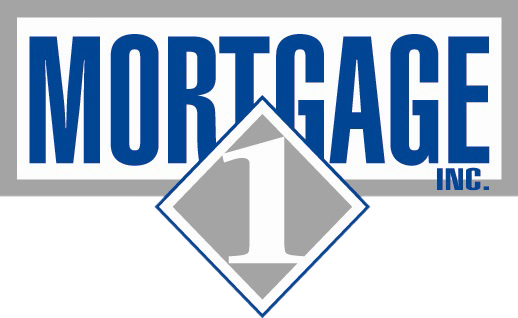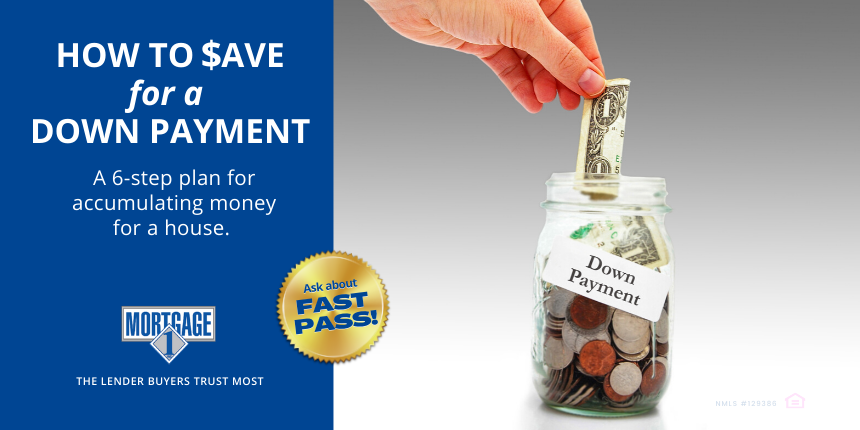
How to Build Equity in Your Home
April 7, 2021
What Is a Real Estate Appraisal and Why Do You Need One?
April 20, 2021A down payment is an important element of home buying. The larger your down payment, the less you will be financing, which saves you money in the long run. A larger down payment can also get you a higher value house or give you more equity out of the gate.
Saving for a down payment can be a challenge for many first-time borrowers. But we’re here to help.
Here’s the Mortgage 1 six-step plan for saving for a down payment.
| Mortgage 1: The Lender You Can Trust Call us at 866-532-0550 or locate a Mortgage 1 loan officer near you. We are the one of the country’s most-trusted mortgage lenders. |
Step 1: Determine How Much You’ll Need
Some potential homebuyers believe they’ll never be able to buy a home because they can’t afford a 20% down payment. The truth is that many lenders no longer require 20% down. So how much do you need for a down payment? There are loans that let you purchase a home for a little as 3% down. You might want to speak with a loan officer from Mortgage 1 to determine how much you can afford and what you will need as a down payment based upon your circumstances. The will give you the end-target goal to save for.
Step 2: Determine When You’ll Need It
What is your time frame for saving? The more time you have, the more achievable your goal will be. You might have to adjust your timing, too. If you had hoped to buy a house this spring but, after looking at your finances you realize that is not achievable, you might have to postpone your home buying plans a few months or even a year. But that’s OK. You want to be in the best position financially when you make a home purchase and the extra time will let you get there.
Step 3: Spend Less $$
This is the most difficult part of the process for many people. There are many options for saving.
- Reduce nonessential spending. Most of us have expenditures in our budgets that, we would acknowledge, are nonessential luxuries. For buyers looking to save for a down payment, eliminating these expenditures can generate a fair amount of quick-win savings.
- Cancel gym memberships: potentially $60 per month
- Eliminate eating out: $200 per month
- Reduce new clothing purchases: $70 per month
- Buy generic brands rather than name brands at the grocery store: $50-70 per month
- Cancel cable TV: $110 per month.
- Cancel other subscriptions: $50-100 per month.
- Pause retirement savings. Saving for retirement is important, of course. But if you are contributing to a 401(k) or IRA, you can pause those contributions temporarily and direct that money toward your Down Payment fund. Once you reach your down payment goal, your can reactivate the retirement contributions. (Consult your financial adviser, of course.)
- Skip vacations and trips. If you travel frequently or take vacations regularly, you can skip those trips and generate large-sum savings. A typical vacation to a resort or destination location can cost several thousand dollars. Skipping the trip and putting that money into your Down Payment fund will generate quick wins.
- Set up an automatic savings plan. Create a Down Payment fund and contribute to it automatically each month. In addition, direct all of the savings generated from the ideas listed here to the fund.
Step 4: Earn/Acquire More $$
Money doesn’t grow on trees, of course. But there are ways to generate more income or money for your down payment goals. Options to consider include:
- Get a second job or side gig. These days, there are many options for getting side gigs that provide quick cash in your pocket. You could become an Uber driver, for example. Or, if you have the skills and work in an industry that hired freelance contractor, you can potentially find side work that generates extra income.
- Borrow. Would your parents or family members be willing to lend you money toward the down payment?
- Ask gift givers to contribute to your down payment fund. If your grandmother regularly buys you clothes for your birthday or holidays, ask if she can use that money to contribute to your DP fund.
- Cash-in old savings bonds or CDs. Do you have savings bonds that have reached maturity? Cash them in and put the money toward your down payment. Likewise, if you have CDs that are nearing maturity and it makes sense to cash them in early, you can use that option. (Consult your financial adviser.)
- Sell valuables. Do you have a coin collection that is worth money? You could sell some or all of the collection to generate money. Likewise, if you have unused equipment or furniture or vehicles, you can sell those easily on eBay.
- Ask for a raise. This sounds bold, but if it’s been a while since you’ve had a raise and you feel you are worth it, you could ask for a raise at work.
- Use your tax refund. If you qualify for a tax refund, save that refund and use it on your house.
- Save your stimulus checks. You know all those stimulus checks Uncle Sam has been sending out? Save yours. Put it to use on a down payment.
Step 5: Establish a Budget
One you’ve determined how much money you will need, when you need it, and where it will come from, put together a budget outlining everything — how much is coming in each month and how much is going out, as well as where it is going. Putting everything down on paper will make you more cognizant of your spending. It will also give a reward by documenting the progress you are making on your journey toward your goal.
Step 6: Put the Plan in Action… and Stick with It!
The final step is to put your plan in action and stick with it. “Plan the work and work the plan,” as they say. Faster than you think, you will see your savings grow and your dream of having enough saved for a down payment become a reality!
The Ultimate Tip: Get Preapproved
Want the ultimate tip? Get preapproved for your mortgage now, before you start shopping. A lender can help you determine how much you’ll qualify for and how much you’ll need. Call us at 866-532-0550 or find a Mortgage 1 Loan Officer near you to get the process started.




